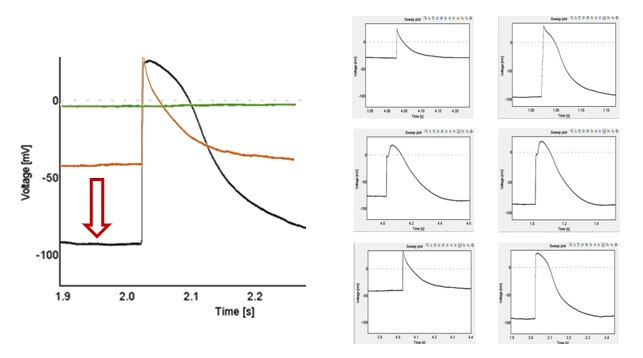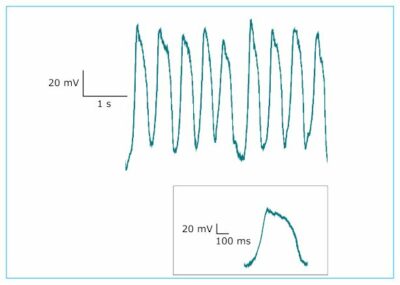Adaptive current clamp
The main challenge with current clamp on automated patch clamp platforms is the cell-cell variability in sealing and, consequently, variation in their resting membrane potential (RMP). This makes it impossible to design one current clamp protocol that works for all cells when working with 16, 48 or 384 cells simultaneously.
If Ihold is too large, a fraction of the experiments with low RMP will clip to avoid cell damage; if Ihold is too small, a fraction of the cells will have an RMP too high to fire an action potential. We can help you solve this challenge with our adaptive current clamp technology.
Conventional or adaptive current clamp
Adaptive current clamp automatically measures and applies a unique current value for each cell. Therefore, each cell can be interrogated independently, analyzed online, and automatically exposed to individual current injections. This individual current injection can obtain a proper resting membrane potential and evoke action potentials that are more uniform across the test plate. With adaptive current clamp, you can increase relevance, quality and success rates considerably.
With Sophion’s automated current clamp, you can either choose the adaptive current clamp feature and evaluate the resting membrane potential individually and set the holding potential accordingly or choose to set the holding potential manually.

Adaptive current clamp can correct the resting membrane potential for each cell in parallel improving AP phenotype and increasing success rates. Left panel: Detailed view. Right panel: Examples of cell without adaptive current clamp (left) and with adaptive current clamp (right)
Individual regulation and control
Sophion’s automated current clamp utilizes an advanced feedback regulation technique that generates the voltage needed to inject the requested current into the cell, as defined in the assay setup software.
The electrical cell-chip parameters are measured for each measurement site before an experiment, to increase measurement stability. The results are used to make individual adjustments to the feedback loop. This advanced regulation and control on individual measurement sites are only possible since we have developed amplifiers specifically for automated patch clamp.
- Individual and automated current regulation and control
- Current clamp or mixed voltage/current clamp recordings in the same sweep
- Easy to upgrade, no new hardware needed
- Avoid cell loss with automated individual clip detection.

Spontaneous action potentials in HL-1 cells recorded in current clamp mode. Insert shows a single action potential on an expanded time scale.
Clip detection saves cells if instability occurs
If, for some reason, the cell-chip parameters shift during an experiment making the measurement site unstable, the implemented clip detection function is triggered. It will return the measurement site to voltage-clamp mode providing the defined holding potential to the cell.
During subsequent protocols, the same cell can again be used to validate compounds in current clamp/voltage clamp or mixed voltage/current clamp mode as set up in the defined assay.
Save your investment in hardware.
The current clamp feature in the Sophion amplifiers is an upgrade option. All Sophion APC solutions can be upgraded with current clamp on request without any need to change or upgrade the hardware.